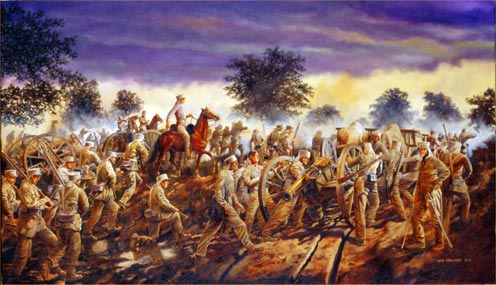
"The Relief of Arrah"
Ref: DR021
by David Rowlands
Giclee Print 58 x 38cm
2 August 1857: Major Vincent Eyre with the men and guns of No. 3 Field Battery, 1st Company, 5th Battalion Bengal Artillery, and a detachment of the 5th (Northumberland) Fusiliers.
In July 1857 Major Eyre was moving his company from Calcutta up into Oudh. Being the wet season of the year, when the river level was high, the gunners and their guns were usually conveyed up the river Ganges by river steamer, while the drivers and horses marched by road. While en route, Eyre heard that three Native Infantry regiments had mutinied and had attacked and besieged the civilian population at the small town of Arrah.
Eyre disembarked his men and guns, collected a party of HM's 5th Fusiliers and set off for Arrah. His own horses not having arrived, he commandeered local bullocks to draw his two 9-pounder guns and one 24-pounder howitzer. His ammunition was carried in country carts. After a march of over 40 miles, he encountered an enemy force of more than 40,000 trained soldiers barring his way at Bibigunge. On the morning of 2nd August he immediately led his small body of troops into the attack, carefully supported by the fire of his guns. Two attempts by the mutineers to rush the guns were broken with salvoes of case shot. After an hour's fighting, the skirmishers of the 5th Fusiliers turned the enemy's right flank. The gunners poured case and shrapnel into their front, and a bayonet charge by the Fusiliers won the day. This battle raised the siege of Arrah.
In the Bengal Artillery all NCOs and gunners carried the 'havildar's sword' and scabbard when on active service. 18 Victoria carbines, fitted with slings, were issued to a (horse) battery. The cartridge pouch, bearing a brass grenade badge, was worn on a waist belt. Indian artillery equipment had seats on the axle-trees of the guns. Being the hot season, the Bengal Artillery were issued with white cap covers and white shell jackets.
The 5th Fusiliers were wearing white smock frocks and trousers. White covers and neck curtains were also made for their forage caps, to which were affixed peaks removed from their unused shakos. They were armed with Enfield rifles.
